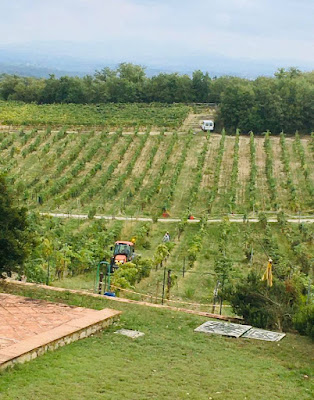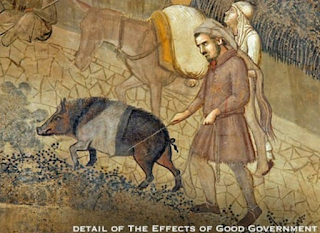 |
| Casamonti's table prepared for wine tasting with an old well in the garden |
"...Anna Rita officiated over the wine tasting and as she poured, she dished out bread and olive oil and Pecorino cheese, in sync with celebrated foodie Waverly Root’s assertion that wine's raison d' être is to accompany food..." (Virginia Billeaud Anderson recounts her visit to Azienda Agricola Casamonti in the Chianti Classico where she toured vineyards and saw the Cinta Senese pig.)
Visiting Azienda Agricola Casamonti in the Chianti Classico - Wine and Cinta Senese Pigs
I’m in the town of Spello, southeast of Assisi, watching inebriated dudes pull a wooden cart containing large wine barrels, decorated with ivy. They flirt with me in Italian, admire my hair, and invite me to drink with them, a deliciously Bacchic scene. Luigi Barzini hit the nail on the head when he called Italy “gloriously pagan,” and said Christianity was a thin veneer over the traditions of ancient Greece and Rome. I had just explored Spello’s Church of Santa Maria Maggiore, begun in 1159 and constructed over a temple dedicated to Juno and Vesta.
I was checking out Umbrian hill towns, and it would be putting it mildly to say the beauty of medieval walls and grape vines and silvery-green olive trees clinging to hillsides around Assisi, Perugia and Orvieto stopped me in my tracks. Naturally I tossed back wine. A Torgiano Rosso Riserva from a vineyard near Perugia for example was smooth and refined. The homemade table wine I drank in the Umbrian countryside on the other hand tasted heavy and bitter. Poured from a thick ceramic pitcher, it called to mind Barbara Grizzuti Harrison’s description of the wine her Calabrian-born grandfather made in Brooklyn, “good-natured, lusty, chewy, raw, ingratiating.” Compared to the fancy Riserva, my host’s wine was awful, but I didn’t mind a bit because I was being given a close-up look at a typical family in the Umbrian countryside. “Why are American children so unhappy,” their young son asked me.
That was in Umbria. Another trip landed Donnie and me in the middle of Tuscany’s Chianti Classico region between Siena and Florence where we went to taste wine. Sipping wine in the Chianti Classico was exciting for several reasons. The sheer beauty of the surrounding Tuscan hills, for one. Also, this region has been regulating wine in some manner since the middle of the 13th century when three wine-producing towns, Castellina, Radda, and Gaiole formed the Chianti League (Lega del Chianti) and made the Black Rooster their insignia. Things became more tightly regulated in 1716 when a ducal decree established Chianti production boundaries. As most readers know, for a wine to be called Chianti Classico and sport the Gallo Nero (Black Rooster) on its label, the grapes must be grown within the designated zone, with stringent regulations governing production and storage.
 |
| Casamonti's Grape vines |
 |
| Anna Rita pours a welcome aparitivo Red Malvasia |
 |
| Casamonti's vineyards |
If you tour Siena’s city hall (Palazzo Pubblico) you will see interior frescoes by the Sienese painter Ambrogio Lorenzetti that date to 1337. The frescoes are essentially a propaganda message that defines “good” and “bad” government for Siena’s citizens. Female personifications of virtues such as “Justice” with her scales, and “Peace,” allegorize good government. Commercial and agricultural activities taking place in Siena and in the countryside represent good government. The fresco shows class distinctions. Craftsmen and merchants conduct business inside Siena’s mediaeval walls. Aristocrats wearing fine robes ride horses while peasants work the field outside the walls, in the countryside. Angels flying overhead indicate God is pleased with the social order, and with smoothly run industry, markets and harvest. Lorenzetti's complex visual narrative includes a depiction of a peasant tending a Cinta Senese pig.
 |
| Cinta Senese in Lorenzetti's Good Government |
 |
| Casamonti Cinta Senese pig |
 |
| Casamonti Cinta Senese pork |
The Cinta Senese breed was named for its black coat with a white sash across shoulders, sides and front legs. By the 1990s, the breed which had been native to Tuscany since before the Middle Ages began to become extinct, so a consortium formed to rescue it. It protects genetic purity with certification and rigorous production guidelines, to guarantee authenticity of pork products in the marketplace. Piglets, zoned to Tuscany, are certified and ear-tagged just after birth. They must be allowed to roam freely, on a minimum amount of land, and are fed by a combination of natural grazing and Tuscan cereals. At Casamonti you can see the pigs root around the estate’s woodlands. They use their long snout to dig for acorns and chestnuts. They enjoy olives. Large floppy ears that hang over their eyes to protect them from branches are a marvelous feat of nature’s genetic engineering. At age two, the pigs get butchered and processed in the estate’s salumificio into salami, finocchiona, and prosciutto. Anna Rita showed us the rooms where pork products are cured and stored.
Cinta Senese are native to Tuscany. The ancient Etruscans began farming them. Etruscans exported to Rome to satisfy the Romans’ hankering for flavorful sausages and salami. The central Italian landscape was an ideal home for the pigs. Oak forests and dense woodlands spread from the Tiber up to the Arno in antiquity, inspiring Waverly Root to write the acorns “fattened” the pigs. Now the forests are thinned out or gone. Italy naturally has other breeds of pigs, such as the wild boars you see on restaurant menus. One of those beasts nearly overran my friend near Castelnuevo de Berandengo. The most common pig is a large white breed known for lean meat. (Not sure which breed the writer Frances Mayes encountered the day her realtor showed her a Tuscan property with chickens running in and out of the house, “the yard was full of rusted equipment and hogs.”) Casamonti on the other hand cultivates a historic and rare breed. And, by the way, has approximately 4000 olive trees, so be sure to buy some of the farm’s Extra Virgin olive oil ("olio") for your Italian “peasant” bread.
 |
| Springtime at Casamonti in Chianti Classico |
 |
| Casamonti Wines |
 |
| Donnie and Virginia at Casamonti in Chianti Classico |
Martha Stewart Visits Lucullus Antiques - Patrick Dunne - New Orleans
Jimmy Domengeaux Chats about His Louisiana Wetlands Photography Exhibition – Interview


No comments:
Post a Comment